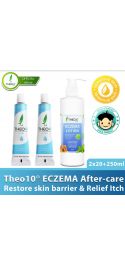
What to avoid during an Eczema outbreak
Eczema outbreaks can be aggravating and unpleasant, but there are steps that can be taken to reduce the severity and duration of the symptoms. Certain triggers should be avoided during an eczema outbreak, according to various medical journals [1][2][3][4][5].
Fragrances are frequently used in personal care products such as perfumes, lotions, and soaps, but they can irritate the skin and exacerbate eczema symptoms [1]. When possible, use fragrance-free products, and look for products labelled "fragrance-free" rather than "unscented," as unscented products may still contain masking fragrances.
Harsh soaps can deplete the skin's natural oils, causing dryness and irritation [2]. Instead, use gentle, non-soap cleansers or moisturising body washes designed for sensitive skin. When showering or bathing, hot water should be avoided because it can dry out the skin and aggravate eczema symptoms.
Wool clothing is itchy and irritating to the skin, making it a common cause of eczema [3]. Instead, choose soft, breathable fabrics like cotton or silk. Tight-fitting clothes should also be avoided because they can irritate the skin and worsen eczema symptoms.
Some people's eczema symptoms can be triggered or exacerbated by stress [4]. While it is impossible to avoid stress entirely, techniques such as mindfulness meditation, deep breathing exercises, and yoga can help to manage it. Getting enough sleep, exercising on a regular basis, and practising self-care can all help to reduce stress.
Extreme temperatures can also aggravate eczema symptoms. Sweating in hot weather can irritate the skin and worsen eczema flare-ups [5]. Cold weather can also cause skin dryness and exacerbate eczema symptoms. Extreme temperatures should be avoided whenever possible, and appropriate protective clothing should be worn in cold weather.
To recap, avoiding fragrances, harsh soaps, wool clothing, stress, and extreme temperatures can help control eczema during an outbreak.
References:
[1] Loden M. Role of topical emollients and moisturizers in the treatment of dry skin barrier disorders. Am J Clin Dermatol. 2003;4(11):771-788. doi:10.2165/00128071-200304110-00002
[2] Fluhr JW, Darlenski R, Lachmann N. The skin and climate change. Int J Hyg Environ Health. 2016;219(2):99-106. doi:10.1016/j.ijheh.2015.10.003
[3] Majeed R, Johnson S. Wool intolerance: the itch with wool. Australas J Dermatol. 2013;54(1):e1-e5. doi:10.1111/j.1440-0960.2011.00857.x
[4] Kim H, Yi Y, Yun Y, Park J, Kim H, Yang J. Association between Stress and Atopic Dermatitis in Adults: A Population-Based Study. Int J Environ Res Public Health. 2017;14(6):557. doi:10.3390/ijerph14060557
[5] Drucker AM, Wang AR, Li WQ, Sevetson E, Block JK, Qureshi AA. The Burden of Atopic Dermatitis: Summary of a Report for the National Eczema Association. J Invest Dermatol. 2017;137(1):26-30. doi:10.1016/j.jid.2016.06
Powered by Mirasvit Magento 2 Extensions
















